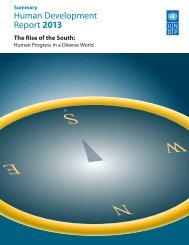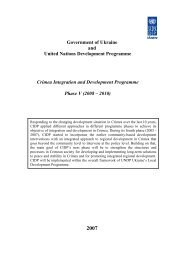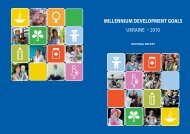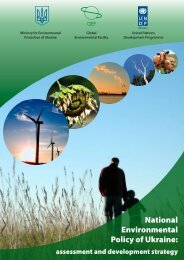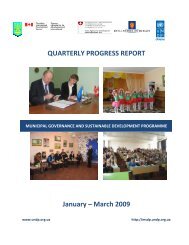E N S W - United Nations Development Programme
E N S W - United Nations Development Programme
E N S W - United Nations Development Programme
You also want an ePaper? Increase the reach of your titles
YUMPU automatically turns print PDFs into web optimized ePapers that Google loves.
Not all countries have<br />
the preconditions for<br />
complete demilitarization,<br />
but most have scope for<br />
substantial slowing in<br />
their military spending<br />
Figure 1.8<br />
Today the majority of security threats come<br />
not from other countries but from insurgencies,<br />
terrorism and other civil conflicts. 62<br />
Conflicts in the post–Cold War era have<br />
claimed more than 5 million casualties, 95% of<br />
them civilians. 63<br />
In South Asia, for example, all nine countries<br />
have experienced internal conflict in the last<br />
two decades, and the resulting casualties have<br />
outnumbered those from interstate conflicts. 64<br />
Moreover, since 2001, more of the conflicts<br />
have been in the poorer regions of those countries<br />
than elsewhere. 65<br />
In 2010, military spending worldwide for<br />
the 104 countries with data available was<br />
more than $1.4 trillion, or 2.6% of world<br />
GDP. Most of the spending was by very<br />
high HDI countries. But as other countries’<br />
economies have grown, particularly medium<br />
HDI countries, their military expenditures<br />
have been increasing. Between 1990 and<br />
2010, military spending more than tripled in<br />
medium HDI countries, while rising close to<br />
50% in low HDI countries and 22% in very<br />
high HDI countries and falling almost 47%<br />
in high HDI countries. Nevertheless, in the<br />
three HDI groups where total military expenditure<br />
grew, the increase was slower than<br />
GDP growth. These aggregates hide considerable<br />
diversity. Europe and Central Asia<br />
saw military spending decline 69% between<br />
1990 and 2010, while South Asia, East Asia<br />
and the Pacific, and the Arab States saw it rise<br />
43%–388%. 66<br />
Although development is often accompanied<br />
by a rise in military spending, this is not always<br />
the case (figure 1.8). The highest shares of military<br />
spending as a proportion of GDP are in<br />
very high and high HDI countries, but some<br />
very high HDI countries have a share below 1%<br />
of GDP, among them Austria, Iceland, Ireland<br />
and Luxembourg.<br />
This is of particular significance for the rising<br />
countries of the South. Costa Rica, for example,<br />
has not had an army since 1948. 67 It spends<br />
nothing on the military and has thus been able<br />
to earmark more funds for social programmes<br />
and social investments. 68 In 2009, it invested<br />
6.3% of GDP in education and 7% in health.<br />
Such choices contributed to its progress on the<br />
HDI from 0.621 in 1980 to 0.773 in 2012.<br />
Today, around 20 countries have small or<br />
no armed forces. They tend to possess small<br />
territories, and many of them rely on external<br />
powers for national security. Not all countries<br />
have the preconditions for complete demilitarization,<br />
but most have scope for substantial<br />
slowing in their military spending. Particularly<br />
with respect to internal conflicts, India has<br />
shown that while policing may be more effective<br />
in curbing violence in the short term, redistribution<br />
and overall development are better<br />
strategies to prevent and contain civil unrest in<br />
the medium term. 69<br />
<strong>Development</strong> is not always accompanied by a rise in military spending<br />
Military spending, 2010 (% of GDP)<br />
12<br />
10<br />
8<br />
6<br />
4<br />
2<br />
0<br />
0.2 0.4 0.6 0.8 1.0<br />
HDI, 2012<br />
Low HDI<br />
Medium HDI<br />
High HDI<br />
Very high HDI<br />
Source: Military expenditure, Stockholm International Peace Research Institute; HDI, HDRO calculations.<br />
* * *<br />
This analysis of the state of human development<br />
is positive and hopeful. Yet much work<br />
remains. Almost every country has challenges<br />
to overcome and opportunities for further<br />
progress. Of particular concern is that some<br />
developed countries, in response to the debt<br />
crisis, are pursuing austerity policies that could<br />
foreclose or reduce future choices and options<br />
for people in the South.<br />
The only viable path to higher human development<br />
is through active investment in enhancing<br />
capabilities and enlarging opportunities. As<br />
the 1991 Human <strong>Development</strong> Report noted,<br />
“People who are healthier, confident, and<br />
skilled will be in a much better position to cope<br />
with a fast-changing environment and meet the<br />
40 | HUMAN DevELOPMENT REPORT 2013



